Powering Vocabulary Growth: Dynamic Strategies to Engage Students and Boost Word Interaction
Building a robust vocabulary is essential for academic success and effective communication. As educators, one of our primary goals is to facilitate meaningful and engaging ways for students to interact with vocabulary. At Richmond, we will explored a range of effective strategies that leverage real-world connections, multisensory experiences, and linguistic analysis to help students develop and retain new words. By incorporating the ideas of using real objects, authentic language, music, word relationships, physical activities, and word roots, we can create a dynamic learning environment that fosters vocabulary growth.
1. Draw Pictures: Encourage students to draw visual representations of new vocabulary words. This visual approach helps students create mental connections between the word and its meaning.
2. Use their 5 senses to understand concepts: One powerful method for introducing new vocabulary is to utilize real objects. By bringing tangible items related to the words being taught into the classroom, students can connect the concept with the physical world. For example, when teaching about fruits, provide actual fruits for students to touch, smell, and taste.
3. Getting points in class for using words in context or finding words in print: Authentic language is key to understanding vocabulary in context. Encourage students to use new words in their own writing and discussions, providing opportunities for them to express themselves using the vocabulary they are learning.
4. Creating songs around words and stories: Music is a powerful mnemonic device and can greatly assist vocabulary retention. Create catchy songs or rhymes that incorporate target words and their definitions. Singing along and repeating the lyrics can help students remember the vocabulary effortlessly.
5. Thinking map and making connection to related words: Drawing connections between related words can enhance vocabulary acquisition. Introduce word pairs or groups that share a common theme, such as synonyms, antonyms, or words with similar roots. By exploring the relationships between these words, students develop a deeper understanding of their meanings and usage.
6. Use Total Physical Response to get students up: Incorporating physical activities and movement into vocabulary lessons can make learning more engaging. Create interactive games like charades, Pictionary, or vocabulary scavenger hunts where students must act out or find objects related to specific words.
7. Use Morphology: Understanding word roots, prefixes, and suffixes can unlock the meanings of countless words. Introduce students to common word roots and their definitions, demonstrating how they contribute to the formation of new words. By analyzing the etymology of words, students can make educated guesses about unfamiliar vocabulary and expand their overall word knowledge.
8. Act it out: Invite students to act out or mime the meaning of vocabulary words. This interactive strategy helps reinforce understanding through physical movement and kinesthetic learning. Students can work individually or in pairs, taking turns to represent different words or concepts. This activity adds an element of fun and encourages students to think creatively.
When teachers employ these effective strategies, educators can cultivate a vibrant vocabulary learning environment. Engaging students through real-world connections, authentic language usage, music, word relationships, physical activities, and word roots can lead to enhanced retention, comprehension, and communication skills. Remember that each learner is unique, so adapt and tailor these strategies to suit your students' needs and interests. With an emphasis on interactive vocabulary learning, we can empower students to become confident and articulate communicators in any field they choose to pursue.
Group of teacher at Richmond practicing vocabulary and Phonics
Citations:
Infographics, eLearning. (2014, January 16). Tips for effective vocabulary instruction infographic - e-learning infographics. e. https://elearninginfographics.com/tips-for-effective-vocabulary-instruction-infographic/
Springer, H. (2022, August 26). Online leveled reading resources for Students & Teachers: Raz-Kids. Online Leveled Reading Resources for Students & Teachers | Raz-Kids. https://www.learninga-z.com/site/products/raz-kids/overview
Verner, S. (2012, November 22). 7 best ways to introduce new vocabulary. Busy Teacher. https://busyteacher.org/13614-how-to-introduce-new-vocabulary-7-best-ways.html

